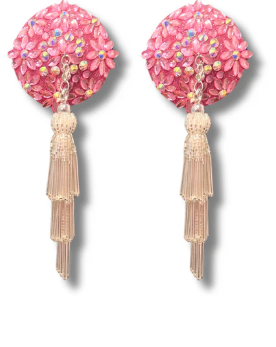Pasties on breasts serve as a practical and versatile alternative to traditional bras, offering coverage, comfort, and style. They are small adhesive coverings designed to shield the nipples, making them ideal for outfits where a bra might not work or be visible. Pasties provide discreet coverage while allowing freedom from bulky undergarments, making them popular for various fashion needs.
Available in disposable and reusable forms, pasties often come with adhesive backing or require additional tape or glue for secure application. They can be found in a wide range of shapes, sizes, and designs, from simple silicone covers to decorative tassels and patterns that add a unique touch. Proper application and skin care are essential to ensure comfort and longevity while wearing pasties.
Whether used for everyday wear, special occasions, or fashion statements, pasties offer a simple solution to nipple coverage without sacrificing comfort or style. Their growing popularity reflects a shift toward more flexible options in lingerie and wardrobe choices.
Understanding Pasties on Breasts
Pasties serve as discreet coverings for the nipples, designed with various materials and styles to meet different needs. They hold a history rooted in cultural expression and practical use, evolving into popular accessories in both fashion and performance settings.
What Pasties Are
Pasties are adhesive patches applied to cover the nipple and areola area on the breast. They are typically small, round, or shaped decals made from fabric, silicone, or other skin-friendly materials. Their primary function is to provide coverage, prevent visible nipple outlines, and allow wearers to go braless under sheer or revealing clothing.
Some pasties include additional features like lift or shaping, offering subtle support without the bulk of a traditional bra. The adhesive quality is crucial for staying in place and avoiding skin irritation.
History and Cultural Significance
Pasties trace back to burlesque and exotic dance traditions primarily from the early 20th century. They became symbols of entertainment and expression while complying with modesty laws. Over time, they also gained cultural recognition in fashion, representing liberation from restrictive undergarments.
In various cultures, pasties have been used not only for modesty but as decorative and artistic elements. Today, they blend practicality with bold style statements, reflecting shifts in societal views on body autonomy and fashion.
Common Types and Materials
Pasties come in several types, each suited for specific purposes:
- Disposable Pasties: Made of lightweight fabric or paper, intended for single use at events.
- Reusable Silicone Covers: Offer a smooth, skin-like feel, are washable, and provide gentle adhesive.
- Decorative Pasties: Feature shapes like stars or hearts, often embellished with sequins or tassels for performance or fashion.
Materials vary from soft fabrics to medical-grade silicone, chosen for comfort, durability, and skin sensitivity.
Popular Uses in Fashion and Performance
In fashion, pasties are used to wear sheer, strapless, or low-cut outfits without visible nipple outlines. They provide modesty without the structure of bras, making them a practical choice for certain styles.
Performers, especially in burlesque or stage shows, use pasties as part of their costume, often incorporating decorative elements for visual appeal. Pasties can also enhance confidence by offering coverage and sometimes subtle shaping, enabling a freer range of clothing choices.
Applying and Styling Pasties on Breasts
Pasties require careful handling for secure placement and comfort. Selecting the correct size and style ensures appropriate coverage and suits different breast shapes. Proper skin care before and after use helps prevent irritation and preserves adhesive quality.
How to Properly Apply Pasties
Before applying pasties, the skin should be clean, dry, and free of oils or lotions. This improves adhesion and prevents slipping. Standing in front of a mirror helps achieve even placement.
One pastie is applied at a time. The pastie should be centered over the nipple, or positioned based on personal preference. Pressing firmly for several seconds ensures a strong, lasting hold.
Keeping arms relaxed during application prevents shifting. Reusable silicone pasties may require hand washing and drying overnight to restore stickiness.
Choosing the Right Fit and Style
Pasties vary in size, shape, and material to suit different needs. Those with larger breasts often benefit from pasties with a wider diameter for adequate coverage.
Material choice affects comfort and durability. Silicone covers provide reutilization and strong adhesion. Disposable options offer convenience but may lack longevity.
Styling options include simple round covers or decorative designs for added flair. The style chosen should complement the outfit and occasion without sacrificing comfort.
| Factor | Recommendation |
| Breast size | Larger pasties for bigger breasts |
| Material | Silicone for reuse; adhesive for disposables |
| Design | Match outfit or personal taste |
Skin Safety and Removal Tips
To protect skin, applying pasties on clean, dry skin is essential. Avoid using on irritated or broken skin to prevent further issues.
When removing, pulling gently at the edges reduces discomfort and skin damage. Residual adhesive can be removed with oil-based products or warm water.
For reusable pasties, hand wash with mild soap and air dry. This maintains adhesive quality and prevents infection.
Taking breaks between uses helps skin recover and decreases sensitivity.


